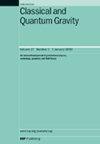重力参照系多频解耦多自由度电容传感:设计与实验验证
IF 3.7
3区 物理与天体物理
Q2 ASTRONOMY & ASTROPHYSICS
引用次数: 0
摘要
在天基引力波探测任务中,多自由度电容传感电路是重力参考系统的关键技术之一。激光干涉仪空间天线探路者(LPF)卫星的GRS基线设计需要独立的注入电极,利用一个通用的高频载波信号对测试质量(TM)的姿态信号进行调幅,这使得电极分布复杂,导致载波信号注入效率低。在本文中,我们提出了一种多自由度电容传感电路结构,通过对每个DOF位移信号检测采用多频载波注入和分频调制,消除了对额外注入电极的需要。我们对该方案进行了全面的分析,包括其基本原理、跨通道注入耦合效应和噪声性能。原理验证实验证明了该设计的可行性,验证结果表明,每个通道的传感分辨率仍然可以达到10−7 pF (Hz1/2)−1。当TM在±1.0 pF运动范围内时,测量到的双自由度通道间的跨通道耦合小于0.32%。该方案对变压器性能提出了更严格的要求,提高了高阶带通滤波器的设计复杂性,同时提供了一种简化电极配置的方法,通过使用相同的电极来实现与LPF基线设计不同的注入-传感-反馈功能,从而提高了注入效率,优化了GRS性能。本文章由计算机程序翻译,如有差异,请以英文原文为准。
Frequency-multiplexed decoupled multi-degree-of-freedom capacitive sensing for gravitational reference system: design and experimental validation
The multiple degree-of-freedom (DOF) capacitive sensing circuits are among the most critical technologies for the gravitational reference system (GRS) in space-based gravitational wave detection missions. The GRS baseline design in the laser interferometer space antenna pathfinder (LPF) satellite requires independent injection electrodes to apply a common high-frequency carrier signal to amplitude modulate the attitude signals of the test mass (TM), which complicates the electrode distribution and results in low injection efficiency of the carrier signal. In this paper, we present a multi-DOF capacitive sensing circuit architecture that eliminates the need for additional injection electrodes by employing multi-frequency carrier injection and split-frequency modulation for each DOF displacement signal detection. We present a comprehensive analysis of the proposed scheme, including its fundamental principle, cross-channel injection coupling effect, and noise performance. A proof-of-principle experiment demonstrates the feasibility of the design, and the validation results show that the sensing resolution of each channel can still reach 10−7 pF (Hz1/2)−1. The measured cross-channel coupling between the two-DOF channels is less than 0.32% when the TM is in the ±1.0 pF motion range. While imposing stricter requirements on transformer performance and elevating the design complexity of higher-order bandpass filters, the proposed scheme provides a way to simplify the electrode configuration by using the same electrodes to achieve the injection-sensing-feedback function differing from the LPF baseline design, which could also improve the injection efficiency and optimize the GRS performance.
求助全文
通过发布文献求助,成功后即可免费获取论文全文。
去求助
来源期刊

Classical and Quantum Gravity
物理-天文与天体物理
CiteScore
7.00
自引率
8.60%
发文量
301
审稿时长
2-4 weeks
期刊介绍:
Classical and Quantum Gravity is an established journal for physicists, mathematicians and cosmologists in the fields of gravitation and the theory of spacetime. The journal is now the acknowledged world leader in classical relativity and all areas of quantum gravity.
 求助内容:
求助内容: 应助结果提醒方式:
应助结果提醒方式:


